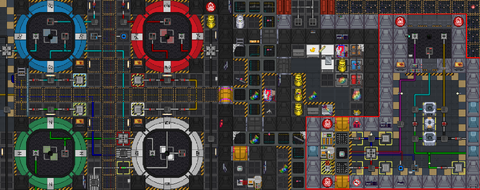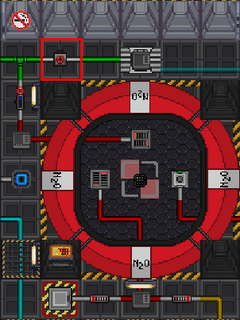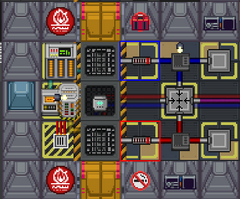Sandbox:CombustionEngine
The Combustion Turbine, sometimes called the Combustion Engine or just Turbine, is a small power unit utilizing flammable gasses to spin a turbine. Due to the low power output, the turbine is typically used as the primary power source for small vessels, or as an auxiliary power unit on larger vessels such as the SCCV Horizon. As such, it is never recommended to operate the Horizon solely off of the turbine, instead the Supermatter Reactor or INDRA should be used.
Turbines fitted onto small vessels are typically found within the engineering section as the central power source. On the Horizon, the turbine is found in Deck 1 Maintenance just east of atmospherics.
Turbine Operation
The turbine is easy to start and operate while leaving opportunity to tweak the set-up for a preferred (or cost effective) operation. Below is the start-up process for the SCCV Horizon. The same principle applies to off-ship vessels, however certain components, such as the gas mixer or pumps, may not be in the same location. Most pumps should be labeled to ease these differences.
- Attach a hydrogen (H2) gas canister to the cold loop connector.
- Unlike the burn chamber, the cold loop is not attached to the Horizon's atmospheric storage. Gas canisters must be used to fill the cold loop.
- Enable the connector to cold loop pump, and the cooling array to turbine pump. This will begin circulation of the cold loop.
- Configure the gas mixer to output east and inject hydrogen and oxygen at the pre-set ratio of 60% oxygen and 40% hydrogen.
- Off-ships will require the use of gas canisters to fill the burn chamber. The Horizon can inject gas from the storage tanks within atmospherics. This requires the use of two pumps, and the activation of a valve shown to the right.
- Note: By opening this valve, the burn chambers will be using the same oxidant as the thrusters.
- Off-ships will require the use of gas canisters to fill the burn chamber. The Horizon can inject gas from the storage tanks within atmospherics. This requires the use of two pumps, and the activation of a valve shown to the right.
- Enable the gas mixer until the desired amount of burn mix has been injected into the burn chamber.
- Disable the gas mixer! Do not leave injection on!
- Ignite the burn mix inside the burn chamber and wait for it to fully burn out.
- On off-ship vessels, some strain on the burn chamber glass at this step is expected.
- Once the fire has stopped and the contents of the tank are 100% CO2, enable hot loop circulation via the Turbine Hot Loop Control console: The recommend configuration is 700L/s input and 1000kpa output.
- The higher you put the output, the more power it generates. Raise as necessary.
WARNING: If you feel the burn mixture is going to break the glass or the burn chamber walls, lower the blast doors and vent the chamber immediately! Off-ship vessels have a portable generator in the back if the turbine runs out of fuel, or another mishap occurs.
Turbine Design
While the layout of the turbine may change from ship to ship, the basic concept remains the same. A turbine is made up of X parts: Burn chamber, hot loop, cold loop, cooling array, TEG, connectors.
The burn chamber is, as you might expect, where the burn mixture is ignited to produce useable fuel. This chamber can vary in size but requires a few basic elements. It needs an injector to inject the burn mixture into the chamber, a vent to bring the hot fuel into the hot loop, a second injector to cycle back the hot loop gas, and blast doors for emergency venting. Some burn chambers may have glass viewing ports, but they're not inherently required. Often times, a sensor is present to display temperature, mixture contents, and chamber pressure to a console on the user.
The hot loop is where the fuel is help from the burn chamber. This loop exits the burn chamber, enters into one of the inlet ports on the TEG, exits out the exhaust port of the TEG, and re-injects into the burn chamber. The ports on the TEG must be across from each other or else the cold and hot loops would be mixed and remove the heat imbalance that causes the TEG to function. Beware that this loop by its nature operates at much higher temperatures and pressures than any other loop and is the most likely to fail if the pressure is too high. If the temperature and pressure become too high, open the emergency cold loop to hot loop valves. This will instantly lower the temperature in the hot loop and open it to the cooling array. This will stop most power production from the turbine.
The cold loop is, as expected, where the cold gas is. Much like the hot loop, it connects to an inlet and exhaust port on the TEG. They must be across from each other. Unlike the hot loop, the cold loop connects to the cooling array. This allows the heat transferred into the cold loop from the hot loop to be emitted into space, which reduces the temperature of the cold loop gas, and increases the heat transfer in the TEG.
The cooling array is similar to the Supermatter Reactor's cooling array. It is a loop of pipes that radiate heat into space and reduce the temperature of the gases within its pipes. Unlike normal pipes, which mechanically act like insulated piping, cooling pipes have a much higher surface area and no insulation, allowing for greater heat removal.
The thermoelectric generator (TEG) is the machine that converts heat in gases to electricity. Rather than operating via high-pressure steam turning an internal turbine, the TEG works through heat transfer between two gas loops. The greater the heat difference, the more electricity produced. It is the exact same machine utilized by the Supermatter Reactor.
Connectors are the ways in which gas is introduced into the turbine system. The Horizon, uniquely, has a direct connection between the burn chamber and its gas storage, however other vessels must use gas canisters to inject fuel into the system, or gas into the cold loop. The burn chamber connectors require an omnimixer to achieve a proper ratio of oxidant to hydrogen. The cold loop, however, does not require any particular mixture.
Turbine Theory
See also: Supermatter Reactor, Guide to Thrusters, and Guide to Atmospherics
The turbine is, in essence, a combination of 2 systems already found on the Horizon: thrusters and the Supermatter engine. Take the burn chamber of the thrusters and attach it to the hot/cold loops of the Supermatter engine. This means that almost all of the theory behind the function of the Turbine can be found within those two systems. The name "turbine" is actually a bit of a misnomer. Unlike typical turbine generators, power is not produced by forcing high-pressure gas through turbine fan blades. Rather, the heat difference between the hot and cold loops generates a voltage through the Seebeck effect. All of this is to say, the only thing that matters in a TEG based power generator is the heat capacity of the gases, and the temperature difference between the hot and cold loop.
To create a temperature difference within the turbine, combustion is used. This is very similar to the thrusters, however unlike the thrusters, we care less about the system pressure and more about the heat of the system. To create combustion, we need three things: oxygen, fuel, and heat. Oxygen is supplied through the oxidant gas, either O2 or N2O. These are the only two oxidants on the Horizon. The only fuels available on the Horizon are phoron and hydrogen. Phoron is notoriously expensive and seldom used beyond the thrusters. As such, we settle for hydrogen. Finally, heat is supplied through the igniter. After the initial fire is begun, the fire will spread throughout the entire chamber until all of the fuel and oxidant is used up. This leaves exclusively CO2, regardless of what fuel or oxidant you use. This makes no sense scientifically, but such is the ways of the mechanics.
The ideal ratio for combustion is 40% fuel and 60% oxidant. This leaves no fuel or oxidant remaining and is thus the most efficient burn. However, this perfect ratio burns at the hottest temperatures. This is great for power generation, but the temperature (>20,000K) would melt the burn chamber walls, which can only handle ~6000K. To prevent this, we can either use a less efficient ratio, which results in a colder burn, or prevent further injection of the burn mix. Once all of the burn mix in the chamber has been combusted, the fire snuffs out and all that remains is superheated gas. Due to SS13 mechanics, this gas does not damage the walls, only fire can damage the walls. This is excellent for us.
This superheated gas can now be utilized much the same way the hot loop gas is used in a Supermatter engine. The superheated gas is circulated from the burn chamber to the TEG, while a cold loop is circulated between the cooling array on the exterior of the ship and the TEG.
Unfinished and has dubious information in it.



